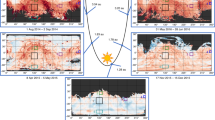Abstract
Since 1950 a number of models have been proposed to explain the observations of comets. For the most part, the icy conglomerate model of Whipple1 has been the standard which others have followed. In light of the recent images made of comet Halley, by the Vega and Giotto spacecraft, we suggest here that the nucleus is composed of rather large (tens of centimetres to hundreds of metres) porous refractory boulders, ‘cemented’ together with an ice–dust grain mix of the icy conglomerate type. This model retains the advantages of the icy conglomerate formalism on a local level, and also introduces a new global framework. We discuss the model in terms of the improving knowledge about comets, the creation of the nucleus in the cosmogonic sense, and expectations of the future analysis of data and observations.
This is a preview of subscription content, access via your institution
Access options
Subscribe to this journal
Receive 51 print issues and online access
$199.00 per year
only $3.90 per issue
Buy this article
- Purchase on Springer Link
- Instant access to full article PDF
Prices may be subject to local taxes which are calculated during checkout
Similar content being viewed by others
References
Whipple, F. L. Astrophys J. 111, 375–349 (1950).
Goldstein, R. M., Jurgens, R. F. & Sekanina, Z. Astr. J. 89, 1745–1754 (1984).
dePater, I. P. & Schenewerk, M. Pap. presented at Conf. Am. Geophys. Un. San Francisco, December 1985; IAU Circ. No. 4142 (1985).
Weissman, P. Nature 320, 242–244 (1986).
Donn, B., Hughes, D. W. & Daniels, P. A. Bull. Am. astr. Soc. 17, 520 (1985).
Keller, U. Pap. presented at Max Planck Institut für Aeronomie Seminar, Katlenburg-Lindau, W. Germany, 2 April 1986 Keller U. et al. Nature 321, 320–326 (1986).
Sagdeev, R. Z., et al. Nature, 321, 259–262 (1986).
Combes, M., et al. Nature 321, 266–268 (1986).
Sekanina, Z. Astr. J. 86, 1741–1773 (1981).
Sekanina, Z. & Larson, S. Nature 321, 357–361 (1986) Astr. J. (submitted).
Kitamura, Y. Icarus (submitted).
Smoluchowski, R., Marie, M. & McWilliam, A. Earth, Moon & Planets, 30, 281–288 1984.
Whipple, F. L. & Stefanik, R. P. in Nature et Origine des Comètes, 13th Liège Symp., 33–51 (1966).
Houpis, H. L. F., Ip, W. -H., & Mendis, D. A. Astrophys. J. 245, 654–667 (1985).
Protostars and Planets II (eds Black, D. C. & Matthews, M. S.) Part VII, pp. 959–1155 (University of Arizona Press, 1985).
Author information
Authors and Affiliations
Rights and permissions
About this article
Cite this article
Gombosi, T., Houpis, H. An icy-glue model of cometary nuclei. Nature 324, 43–44 (1986). https://doi.org/10.1038/324043a0
Received:
Accepted:
Issue Date:
DOI: https://doi.org/10.1038/324043a0
This article is cited by
-
The Subsurface Structure and Density of Cometary Nuclei
Space Science Reviews (2015)
-
INTERPLANETARY DUST AND CARBONACEOUS METEORITES: CONSTRAINTS ON POROSITY, MINERALOGY AND CHEMISTRY OF METEORS FROM RUBBLE-PILE PLANETESIMALS
Earth, Moon, and Planets (2004)
-
Penetration of large meteoroids into the atmosphere: Theory and observations
Journal of Engineering Physics and Thermophysics (1999)
Comments
By submitting a comment you agree to abide by our Terms and Community Guidelines. If you find something abusive or that does not comply with our terms or guidelines please flag it as inappropriate.



